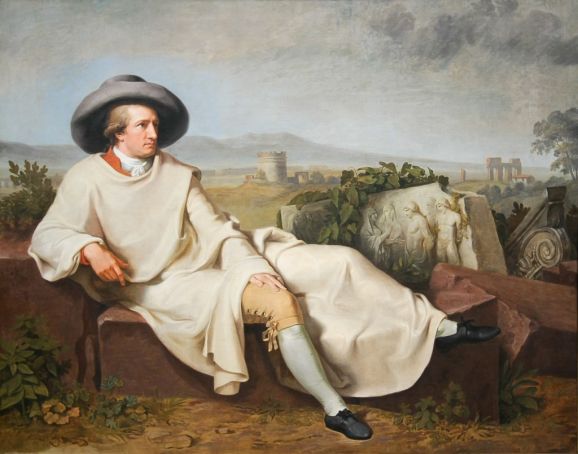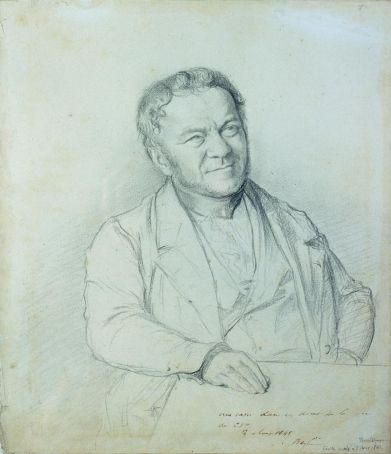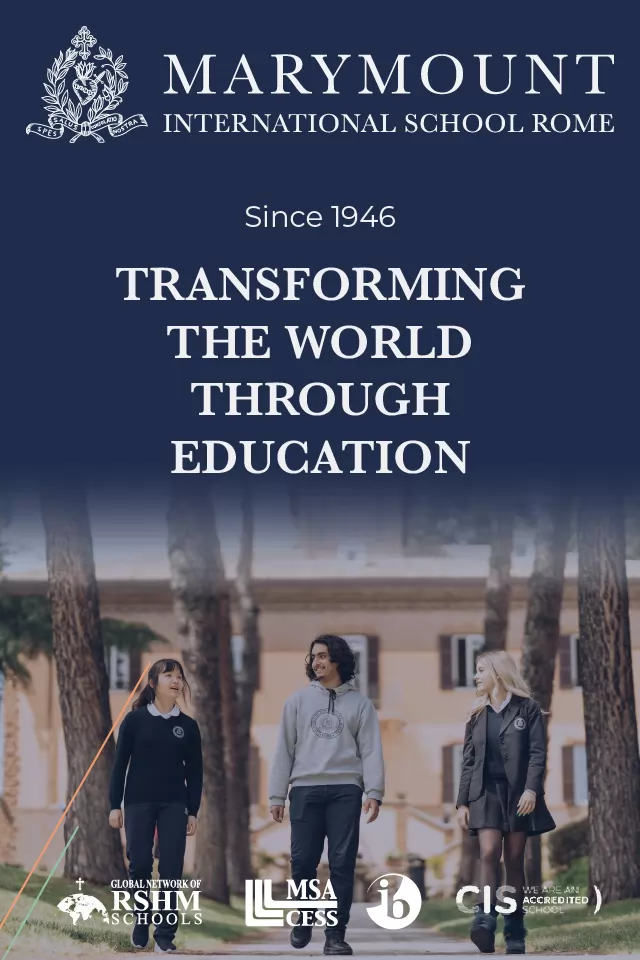Looking at Rome through the eyes of just a few of its illustrious tourists
“In this place we can reconnect with all the history of the world, and I count myself reborn, really resurrected, the day I set foot in Rome. Her beautiful sights lifted me little by little to their own height.” It is no small thing the impatient Goethe demands of Rome. He had “slipped away” from his court duties and a love affair in Weimar, and rushing to the Eternal City, wanted to start immediately to write and to love. He was not the only one. Reaching the “capital of the world” was a dream shared by noble spirits fleeing their home countries and their routine, and many of these “grand tourists” hoped that a plunge into the city could radically transform them – for the better, obviously.
Mythical Rome, the Rome of their dreams, sometimes disappointing, sometimes exciting: “that famous city which was the object of my desire for 30 years” for the French financier Pierre Jacques Onésyme Bergeret (1774) and which Goethe was impatient to see. “My eagerness to reach Rome was so great, increasing at every moment, that I had no rest and stopped only three hours in Florence. Now here I am, at peace, and it would seem appeased for the rest of my life,” he wrote.
Stendhal, constantly wavering between admiration and indignation during his journeys in Italy, cannot hide his bafflement on his umpteenth arrival in Rome, even teasing himself a little: “This is the sixth time I have come to the Eternal City, but I am again deeply moved. From time immemorial it has been the habit of sensitive people to be bemused on arriving in Rome, so I am almost ashamed of what I am setting down.”

As in every initiatory journey, arriving in Rome, too, has its obligatory rite. From French nobleman Montaigne, writing in his diary in 1580, to Stendhal in 1817, the point of entry was always the same: Porta del Popolo.
Goethe records that “only when I passed under Porta del Popolo was I certain that Rome belonged to me”, while in Stendhal we find the familiar impatience, due to the fact that his diary was a political document more than anything else: “I enter Rome by the Porta del Popolo; I lodge on the Corso, Palazzo Ruspoli. But what a disappointment! It is not as grand as the entry to almost all the great cities I know,” he declares in his book Rome, Naples and Florence (1817), referring to Paris and Berlin. Montaigne and Goethe lodged instead in the same hotel, although centuries apart. The Albergo dell’Orso, which exists still today as the Hosteria on the corner of Via dell'Orso and Via dei Soldati, must have been one of the most fashionable places to stay in the capital.
Once they had conquered a reasonable bed and the company of some respectable compatriots, the great travellers could examine the delights of Rome. The objects of their interest changed radically over the centuries. For the 16th-century traveller, Rome was above all the centre of Christianity and the custodian of imperial memories, and its contemporary appearance was ignored in both guide-books and travel diaries. When describing the city, they paid attention to the Catholic rites, to the ancient statues of Laocoön or Apollo, or to the ruins which, to the foreigners’ dismay, looked more like “piles of stones” than noble temples. A concept of Rome which was to change only a century later when the number of foreign visitors increased dramatically, when the works of artists like Bernini or Domenichino found a place among the noteworthy attractions.
One example of this new vision of Rome and the change in the taste of men of the 17th century can be found in the travel diary of the Englishman John Evelyn, who arrived in the city in 1644. Describing Michelangelo's Moses in the church of St Peter in Chains, he writes: “One cannot tire of contemplating it”; he praises Bernini at some length, and writes that the Last Judgement is a “product of a miraculous imagination.” For a foreigner, the attractions of Rome were infinite and unrivalled: “Elsewhere one needs to seek out what is important,” wrote Goethe; “here we are oppressed and crushed by it.” The same sensation also inspired Stendhal to provide some advice on how to avoid losing track among the capital’s artistic wonders: “When you arrive in Rome ... have yourself taken to the Colosseum or to St Peter’s. If you try to walk there, you will never arrive: there are too many wonderful things to stop you along the way.”
Although the number of travellers must have been fairly low in the 16th century, rising exponentially during the 17th and 18th centuries, Montaigne still complained of the many, too many Frenchmen flooding the city. His secretary wrote that “Monsieur de Montaigne was annoyed by the large number of Frenchmen he found, so many that he could hardly cross anybody’s path in the street without being hailed in his own language ... for many reasons, and in particular for the multitude of passers-by, the aspect of the streets reminded him more of Paris than of any other city he had visited.” But if Montaigne complained of the French, it was the English who annoyed Stendhal, with such a huge number of them in the streets of Rome that he wrote, “In Italy I am making a journey to England.”
The comparison with Paris is a constant in the Essais of Montaigne. Compared to his capital city, Rome seems much smaller, but “as for the number and vast size of the public squares, and the beauty of streets and houses, Rome wins by a long way.” And in Evelyn's eyes, even compared with 17th-century London, Rome appeared to be a less rich and populous town.
Although Italy’s climate and art can bewitch even the severest soul, it seems clear that the population was not held in high esteem. Montaigne uses many of the modern clichés to describe Romans: “The usual occupation of Romans consists of strolling in the streets; usually when they prepare to go out, they do so merely to go from street to street, because they have no destination which they wish to reach; and there are streets which are particularly suited for that purpose. To tell the truth, the greatest profit to be had from this is to see the ladies in the windows, particularly the courtesans.” Goethe seems instead to be have been quite disarmed by the Roman low-life in a city which, fortunately, was a far cry from today’s: “I do not know what to say of this people but that it is a tribe in a natural state and, even living among the magnificence and majesty of the religion and the art, not a hair different from how they would be if they lived in a cave and in the woods” (1786).
Along with the criticism we also find kind words about the Italians: if nothing else, they are at least likeable. First among these is the Englishman Richard Lassels, Roman Catholic priest and early travel writer, who admired above all else the helpfulness of the Italians for foreigners: “They never insult foreigners, no matter in what condition they show themselves”, thus confirming what Montaigne had said of Rome: “A city with the most cosmopolitan character in the world, where they least care whether one is a foreigner or from another nation.”
Stendhal, particularly in Rome, Naples and Florence, is far more critical, but still recognising an unrivalled levity and helpfulness in the population: “Everything here is decadence, everything is memory, everything is death. Active life is in London or Paris. On days when I am the prey of simpatia, I would prefer Rome.” For some, the role of jester suits the city even today: “The ideal (for Stendhal) would be an active life alternating with repose with the pleasures of Rome’s sweet climate.” But the real enemy of the Passeggiate Romane (1829) seems to have been the tourism which thronged Rome’s monuments. “The sight of so many bored fools has ruined Rome for me,” he writes, reminding us of many recent remarks, and continues: “No sooner do more tourists arrive in the Colosseum than the visitor’s pleasure completely fades. It is no longer possible to lose oneself in sublime daydreams: despite oneself one is forced to notice the absurdity in which the new arrivals seem rich.”

If the arrival is always charged with emotion, the departure from Rome is marked by a profound sadness. Evelyn took his leave from a hill near Porta del Popolo, noting that “from up there the city, on such a simply glorious day, it was not without regret that I gave her my last adieu.” Leaving his “capital of the world” forced Goethe to observe everything several times to create a more lasting memory: “I am on the move from morning to evening, I go to see what I haven’t seen yet, and go to see again the most important things, for a second and a third time.”
So different, so great, each with his Rome, with his frustrations and his hope of rebirth, the writers with their diaries, intimate or for printing, they are a wonderful guide for rediscovering the city with new eyes, with nothing taken for granted. Thanks to them we can reconquer the surprise, the emotion, the attention, also reconquering together with a vision untrammelled with platitudes fragments of a great “history of European conscience” written over centuries by witnesses of the city (and of their own life).
Arianna Farina
This article was published in the 4 March 2015 edition of Wanted in Rome magazine.





















